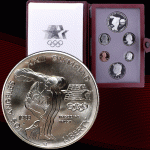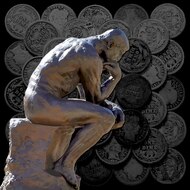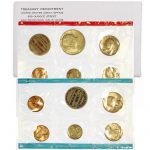
National Coin Week
National Coin Week Here’s an excerpt from the Mint’s Website regarding National Coin Week, “The third week in April is National Coin Week, a week dedicated
 How do you know if that dusty, old shoe box full of coins in the back of your closet has any silver in it? Or if that jar full of spare change on the mantle has some surprises in store for you? How do you tell if a coin is silver of not? Several tests exist to determine the silver content of a coin. There are simple, quick and easy observations one can make of one’s own collection, to see if any goodies lie therein.
How do you know if that dusty, old shoe box full of coins in the back of your closet has any silver in it? Or if that jar full of spare change on the mantle has some surprises in store for you? How do you tell if a coin is silver of not? Several tests exist to determine the silver content of a coin. There are simple, quick and easy observations one can make of one’s own collection, to see if any goodies lie therein.
Probably the easiest, and also the most foolproof method for determining a coin’s silver content is its date. Every coin minted in the U.S. has a date on the face side of the coin, and dimes, quarters, half dollars, and dollar coins minted in 1964 and earlier have a ninety percent silver content. If you’re rummaging through your collection and you happen to come across an old quarter, dime, half dollar, or dollar that dates before 1965 then you’re in luck! That’s ninety percent silver right there!
Also, as a side note, the Kennedy half dollars minted in 1965 to 1970 were made with forty percent silver, and in 1976 forty percent silver quarters, half dollars, and dollar coins were made. Not quite as valuable, but definitely worth keeping an eye out for!
The appearance of a coin can be another indicator of whether or not it’s silver. They actually have a different look to them than the “clad” (regular copper/nickel) coins. These clad coins are actually a bit of a sandwich. Imagine two plates of nickel being pressed onto a piece of copper, then stamped and finished up. Well, that’s how regular dimes, quarters, half dollars, and dollar coins are made. The nickel is applied to the coin to help preserve its appearance, as copper corrodes easier than nickel does. And since the copper/nickel alloy is actually a harder metal than regular silver, silver coins that have been in circulation tend to have a softer, less defined, more worn look, and sometimes have distinctive dark or tarnished areas on its surface.
Grab a quarter out of your pocket. Take a look at the rim of the coin. Notice how it’s kinda brown, while the two faces of the coin are the typical silvery color? On the rim of the coin the copper is actually showing through where the nickel didn’t fully cover. This brown rim indicative of clad coins does not appear on silver coins. The rims of the silver coins are actually the same color as the rest of the coin.
This method is especially useful if you have a bunch of coins rolled in plastic, see-through rolls that the bank sometimes issues. You can just take a look through the clear plastic roll at the rims of all the coins to determine if any are silver or not. Now, granted this method isn’t fool proof. Coins wear out, and when they’re all sandwiched together in a tight roll then looks can sometimes be deceiving. But this method works well if one is a busy fellow and just wants to do a quick check. To be thorough though, one should break each roll out and check the date of each coin for a really, really complete search.
Next, the weight of a coin can actually tell you what kind of metal it’s made of. Granted you’ll need a very delicate measuring device, perhaps a postal scale or a jeweler’s scale to determine this, and also granted a coin will lose some of its weight through circulation caused by abrasion, destruction, and rubbing, but this method is still quite effective.
Basically silver weighs more than the usual copper-nickel alloy. For example a run-of-the-mill Washington quarter weighs 5.67 grams, and a silver Washington quarter will weigh in at 6.25 grams, a little more than half a gram difference.
Finally, the sound a coin makes when dropped onto a hard surface is also an indicator of its make-up. Silver coins when dropped onto something hard produce a very distinctive ringing tune, where clad coins make more of a thud. The sound is actually so unique, that some experts who have worked with a lot of silver can actually tell if a coin is silver or not, simply by dropping it on the table.
Using these four above methods: date, appearance, weight, and sound you can accurately see if your coins are silver or not. No need to take them to a jeweler or pawn shop to determine their make-up now. And for anyone with a lot of coins and some free time, applying this data can be a fun way to spend a rainy day, and possibly profitable too! So good luck and happy searching!

National Coin Week Here’s an excerpt from the Mint’s Website regarding National Coin Week, “The third week in April is National Coin Week, a week dedicated

The Kennedy half dollar has been one of the most recognizable and one of the most iconic coins in the United States of America. It

Producing an adequate quantity of coins for common use has often been a challenge. The U.S. stopped producing coins for collectors in 1942. Metals were
The easiest way to get in contact with us is by filling out the form and submitting it.
We will contact you as soon as we can.
David Enders
PO Box 508
Athens MI 49011
The Dave’s Collectible Coins customer service goal is simple:
We are committed to providing our customers total satisfaction. Every time. Guaranteed.
For non-urgent matters please use the form in this popup. For urgent matters please call 269-742-4716.
Customer service is available Monday – Friday 8:00am – 4:30pm EST